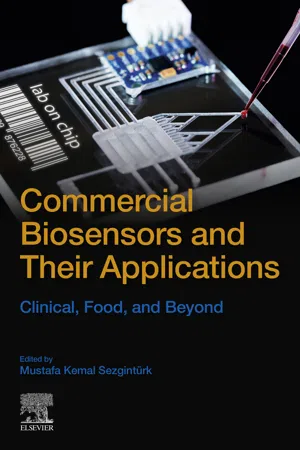
Commercial Biosensors and Their Applications
Clinical, Food, and Beyond
- 374 pages
- English
- ePUB (mobile friendly)
- Available on iOS & Android
About This Book
Commercial Biosensors and Their Applications: Clinical, Food, and Beyond offers professionals an in-depth look at some of the most significant applications of commercially available biosensor-based instrumentation in the clinical, food quality control, bioprocess monitoring, and bio threat fields. Featuring contributions by an international team of scientists, this book provides readers with an unparalleled opportunity to see how their colleagues around the world are using these powerful tools. This book is an indispensable addition to the reference libraries of biosensor technologists, analytical chemists, clinical chemists, biochemists, physicians, medical doctors, engineers, and clinical biochemists.
The book discusses the need for portable, rapid, and smart biosensing devices and their use as cost-effective, in situ, real-time analytical tools in a variety of fields.
- Devotes several chapters to applications of biosensors to clinical samples, exploring how biosensors are currently used for in-home diabetes monitoring, point-of-care diagnostics, non-invasive sensing, and biomedical research
- Includes a section on food applications covering how biosensors can detect genetically modified organisms, toxins, allergens, hormones, microorganisms, species-specificity, pesticides, insecticides, and related components
- Discusses nanobiosensor and applications, including a chapter on nanotechnological approaches and materials in commercial biosensors
Frequently asked questions
Information
Introduction to commercial biosensors
Abstract
Keywords
1. Introduction
2. What is a biosensor?

Reprinted with permission D. Liu, J. Wang, L. Wu, Y. Huang, Y. Zhang, M. Zhu and C. Yang, Trends in miniaturized biosensors for point-of-care testing, TrAc Trends Anal. Chem. 2019, 115701.
3. Bioreceptors and transducers used in biosensors
3.1. Bioreceptors
Table of contents
- Cover image
- Title page
- Table of Contents
- Copyright
- Contributors
- Chapter One. Introduction to commercial biosensors
- Chapter Two. Personal blood glucose analyzers
- Chapter Three. Electrochemical affinity biosensors for hormones and related biomarkers: from laboratory to commercial point-of-care testing
- Chapter Four. Overview to recent commercial biosensors for diagnosis of cancers, cardiac diseases, and other diseases
- Chapter Five. Commercial sensors for pathogen detection
- Chapter Six. Paper-based devices
- Chapter Seven. Noninvasive biosensors for diagnostic biomarkers
- Chapter Eight. Commercial biosensors for detection of food additives, contaminants, and pathogens
- Chapter Nine. Bioassays and biosensors for food analysis: focus on allergens and food packaging
- Chapter Ten. Bioprocess monitoring by biosensor-based technologies
- Chapter Eleven. Biosensors commercial off the shelf in biological warfare attack
- Chapter Twelve. Nanotechnological approaches and materials in commercial biosensors
- Index